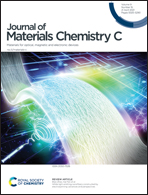Rb3In(SO4)3: a defluorinated mixed main-group metal sulfate for ultraviolet transparent nonlinear optical materials with a large optical band gap†
Abstract
Ultraviolet (UV) nonlinear optical (NLO) materials possess important practical applications in modern laser science and technology, which are attracting significant research interest in the fields of chemistry, physics and materials science. A fluorinated mixed main-group metal sulfate and its defluorinated analogue, Rb2InF3(SO4) (RIFSO) and Rb3In(SO4)3 (RISO), were designed and synthesized for NLO study via mild hydrothermal methods. RIFSO unfortunately crystallizes in centric space group Pbcn (no. 60) while RISO crystallizes in acentric space group R3c (no. 161). Both of them exhibit a one-dimensional chain structure composed of corner-shared [InO2F4] or [InO6] and [SO4] groups. Optical property studies reveal that RISO displays a large band gap (5.75 eV) corresponding to a short UV cut-off edge (215 nm), a moderate second harmonic generation (SHG) efficiency of ∼0.5 times that of KH2PO4 (KDP) with phase-matchable performance, and high thermostability (>800 °C), demonstrating its potential as an applicable UV NLO material. First-principles calculations have been performed to further elucidate the structure–property relationship of RISO.



 Please wait while we load your content...
Please wait while we load your content...